Whether you have a dedicated project manager in your game development team or not, you have to treat the game as what it is — a project. That is, if you want to finish it on time and within budget.
So, even as a game developer, you should use project management tools and practices to organize your efforts.
Luckily for you, I’ve compiled a list of the 7 best project management tools for game development to help you find the perfect fit. Read on to find out how each app stands out!

In this article:
Top 7 game project management tools — overview
Task management is the most important aspect of any project management software. And, it’s just as important for video game developers since all PM tools are built around task management.
This essentially means you can use any PM tool to manage game projects, and it will work.
However, if you want the best tools that cater specifically to game development, then the following 7 are the ones to look out for.
| Software | Free plan | Pricing (starting at) | Best for |
|---|---|---|---|
| Plaky | ✔ | $3.99/seat/month | Free game project management |
| HacknPlan | ✔ | €7/month | Kanban-style game project management |
| Codecks | ✔ | €5/user/month | Tracking game project milestones |
| Jira | ✔ | $8.60/user/month | Scrum game project management |
| Trello | ✔ | $5/user/month | Showcasing progress on Patreon-backed or crowdfunded games |
| ClickUp | ✔ | $7/user/month | Integration with other apps |
| Asana | ✔ | $10.99/user/month | Workload management |
How I choose my favorite game project management tools for this list
When thinking about video games, the first titles that spring to mind are the high-production games like Baldur’s Gate 3, Spider-Man, or GTA. But the reality of game development is that games like these account for a minuscule percentage of the market.
Most games don’t have hundreds of people working on them — a more realistic and relatable number of people working on a game development team is a couple of dozen or so, with many teams counting in the single digits.
So, when making this selection, I made sure to include only tools with free plans that even an aspiring developer can use to start chasing their dreams.
That said, all the tools highlighted in this guide also have features to accommodate large teams and their needs.
In fact, I choose some tools precisely for their ease of use — something that’s more important in larger teams that aren’t 100% composed of developers who are, by their nature, tech-savvy.
#1 Plaky — best free game project management software
Plaky is a free and powerful project management tool that offers enough flexibility and customization features to conform to the needs of any game development project.
Why choose Plaky?
Plaky doesn’t limit the number of users who can join your Space, even in its free plan. So, your Spaces can always be scaled to accommodate the growth of your development team.
Manage game projects with Plaky
Plus, since Plaky primarily focuses on task management and workflow optimization, it lets you create the perfect organizational structure for each team — and each stage of game development.
| Plaky’s pros | Plaky’s cons |
|---|---|
| – Powerful free plan and affordable premium plans – No limit on the number of users on any plan – Fully customizable task fields that cater to any workflow – Subtasks and task-specific comments that facilitate collaboration and keep development organized | – Lack of integrations (only integrates with Clockify at the moment) |

Plaky’s generous free plan — with unlimited users, projects, and tasks — certainly has its appeal. That said, what actually makes Plaky such fantastic game development project management software is its customizability.
You can customize everything to fit the needs of your project and the teams working on it. You’re free to decide which custom fields each task on a board will have, including but not limited to:
- Assignees,
- Status,
- Priority,
- Reviewers,
- Due dates, and
- Links.
You can also customize the way this information is visually presented using 3 different views:
- Table view — for a condensed overview of key project information,
- Kanban view — to organize tasks into custom Kanban columns, and
- Gantt chart view — to visually track your project timeline (available on Plaky’s paid plans).
Each team can customize their Spaces differently, which includes using their preferred views. For example, the level design team may perform best with a Kanban board while the multiplayer backend team prefers their tasks organized in lists.
The only real downside of Plaky is its lack of integrations. At the moment, Plaky only has an integration with Clockify for time tracking and an integration with Pumble, which allows you to receive task updates directly in your company communication software.
This means that teams with already established workflows that rely on a bunch of external tools may find it cumbersome to integrate into their existing task management.
💡Plaky Pro Tip
Find out how game dev teams can benefit from using Plaky in our in-depth guide:
What’s new in Plaky?
In addition to subtasks, Plaky’s newest update includes the ability to use a single account to log into all CAKE.com Suite products.
Available platforms: web, iOS, Android
| Plaky’s plans | Plaky’s pricing |
|---|---|
| Free | $0 |
| Pro | $3.99/seat/month* |
| Enterprise | $8.99/seat/month* |
*billed annually

#2 HacknPlan — best for Kanban-style game project management
HacknPlan is a Kanban-oriented project management tool created specifically for game development.
Out of the box, boards come with pre-made categories for grouping tasks by:
- Programming,
- Art,
- Sound, etc.
Why choose HacknPlan?
HacknPlan stands out because it implements a lot of features specifically made for game planning and development. Just to give an example, it features in-app 3D model visualization, which goes a long way when developing anything that uses 3D models.
| HacknPlan’s pros | HacknPlan’s cons |
|---|---|
| – Optimized for Kanban workflows – Task dependencies – Game Design Model feature – In-app 3D model visualization | – Free plan is missing basic functionalities, like Kanban column customization and card fields |
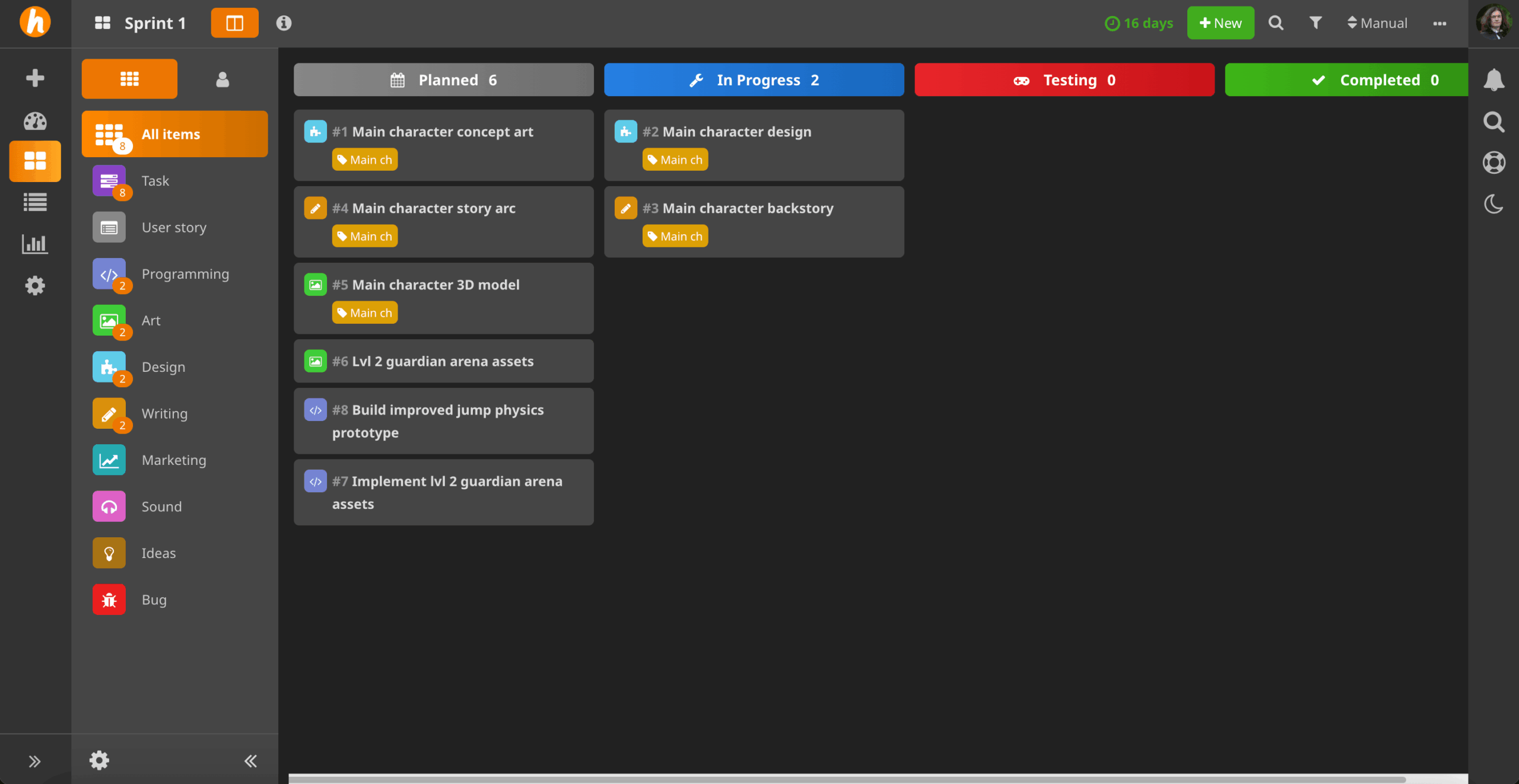
As far as task management in HacknPlan goes, it’s your standard fare task card drag-and-dropping that all Kanban workflows utilize. However, HacknPlan does add a few elements that not all similar platforms have, such as linking task dependencies.
This means that when you’re creating a task, you can list which other activities must be completed before it can be unlocked.
For example, if you’re creating an NPC, you can’t make the 3D model until the character design and concept art are made. So, until these conditions are met, the 3D modeling task will feature a locked icon.
Another standout game development feature is the Game Design Model (GDM).
The GDM serves as your main game design document — the most crucial piece of documentation for defining the project vision and keeping everyone on the same page.
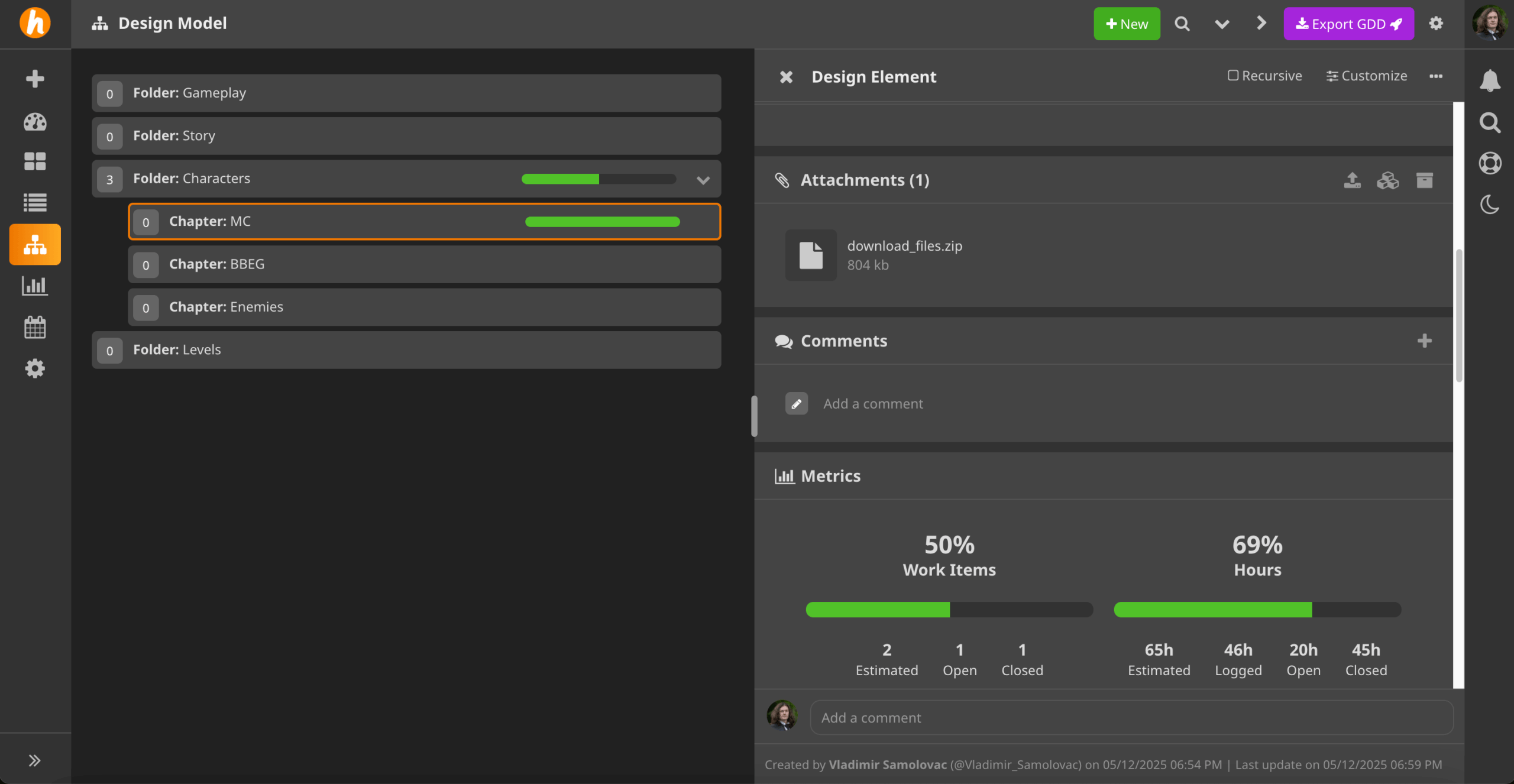
The main problem with game design documentation is keeping it alive and regularly updated, especially once project teams get big.
HacknPlan’s GDM feature streamlines this documentation by linking it with task management. This turns a normally static and disparate document into a dynamic and interlinked part of the development process.
An integrated game design document like this also allows you to track the metrics of each game design element in real time. For example, you can easily check how well the 2D art is progressing or how the UI is coming along.
But it’s not all sunshine and rainbows, especially for small teams and devs who are just starting out. This is because HacknPlan’s free plan lacks a lot of basic task management functionalities that most other tools provide, like Kanban column customization and field cards.
What’s new in HacknPlan?
HacknPlan’s newest feature is 3D file visualization, making it the only project management tool on the market that offers this functionality.
Available platforms: web
| HacknPlan’s plans | HacknPlan’s pricing |
|---|---|
| Personal | €0 |
| Personal Plus | €7/month |
| Studio | €9/seat/month |
*billed monthly
#3 Codecks — best for tracking game project milestones
Codecks is yet another game development-specific project management tool, only this one has a unique spin — trading cards.
Namely, task management is split into 3 windows:
- Hand — which contains personal cards visible only to the user,
- Decks — groups of cards that are visible to multiple relevant people, and
- Timeline — which lets you assign tasks to milestones to track progress in meaningful chunks.
The idea is that you draw cards (tasks) from a deck and then play the cards from your hand, or in this case — perform the tasks you’ve drawn.
Why choose Codecks?
For me, the main appeal of Codecks has got to be the gamification of game development. Technically, it doesn’t do a lot of things differently than the other tools, but it just presents everything in a manner that is more likely to appeal to a gamer.
I can easily see how this software would help an aspiring developer push through the process of actually making their first game.
| Codecks’ pros | Codecks’ cons |
|---|---|
| – Timeline feature for managing tasks related to a milestone – Guardian System feature allows for intuitive workflow customization and permission control within decks – Built-in time tracker | – Task cards use Markdown, making them less user-friendly for larger teams – The broken changelog page on their website does not inspire confidence in the tool and the team developing it |
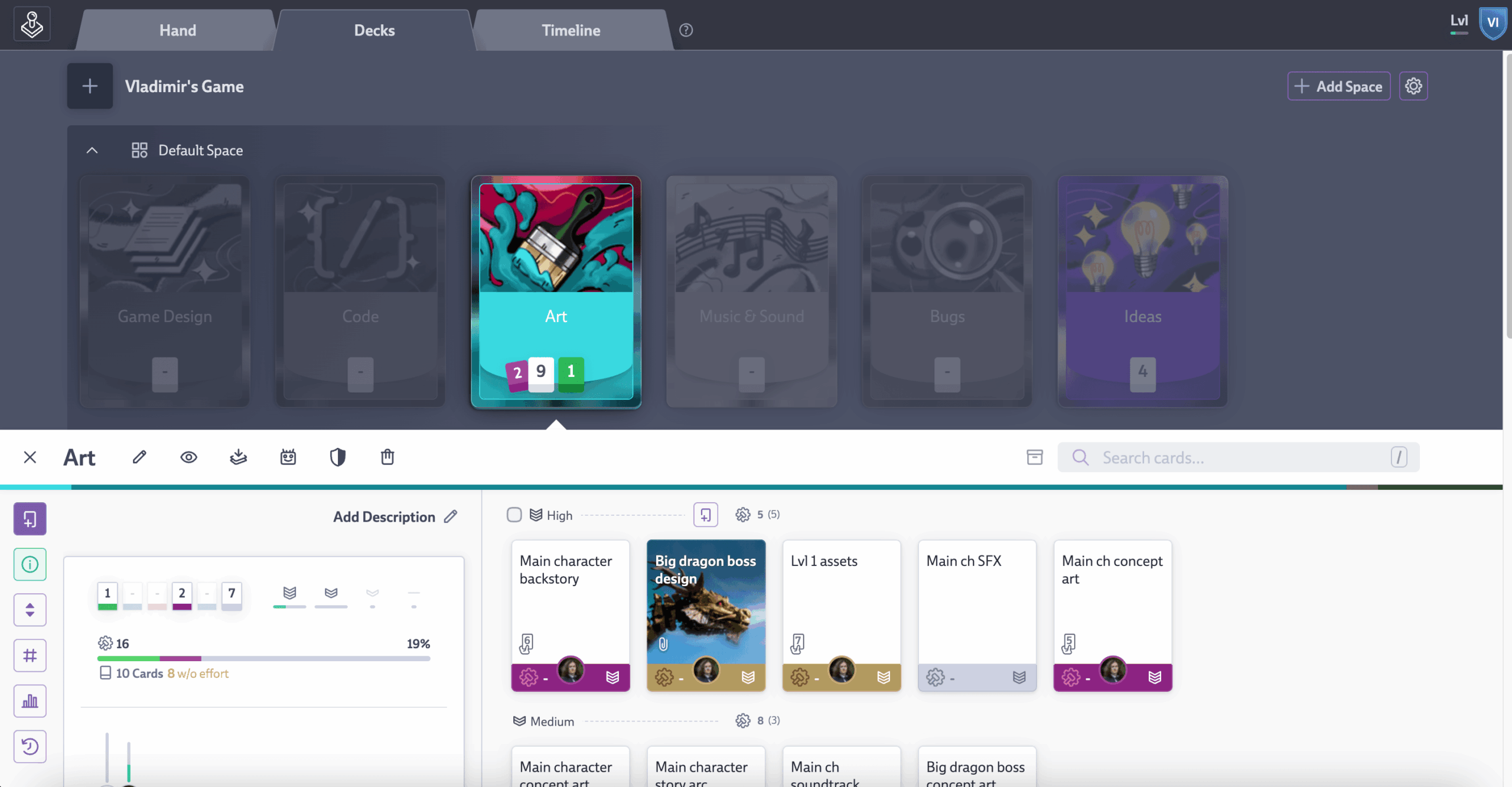
To be fair, it’s not like the task management gimmick is the only thing Codecks has going for it. The card-playing approach to task organization and sorting is unique, but the most valuable asset has got to be its timeline feature.
This feature allows you to mark a date on the project timeline and effortlessly assign tasks to it. You can then track the team’s collective progress toward this milestone.
This is especially useful when the team needs to prepare something, like a presentation or a demo, for a specific event. It also comes in handy when you want to narrow down the number of cards to keep track of and only focus on the cards related to a specific milestone.

Codecks isn’t the only tool with this kind of feature, but its milestones are the most intuitive to use. But, while the app is great for devs, it’s punishing for the less tech-savvy.
For example, the task cards use Markdown. This isn’t a problem for solo devs or small teams — in fact, they’d appreciate the flexible formatting — but it becomes a problem as more people and different departments get involved.
What’s new in Codecks?
The newish feature that immediately struck my attention when revisiting Codecks was the built-in time tracker. Whether or not this is the latest feature, I could not tell you since their changelog page was very much broken at the time of writing this review. Yikes!
Available platforms: web
| Codecks’ plans | Codecks’ pricing* |
|---|---|
| Free | €0 (up to 5 users) |
| Plus | €5/user/month |
| Pro | €9/user/month |
| Enterprise | €15/user/month |
*no annual payment
#4 Jira — best for Scrum game project management
Jira is a project management tool that can do pretty much anything if you know how to wield it properly.
It was released way back in 2002, so its enduring popularity is the only testament to its quality that it needs.
Why choose Jira?
While all project management tools featured on this list support Agile game development, they mostly do so with the help of Kanban boards. Jira, on the other hand, supports both Kanban and Scrum workflows.
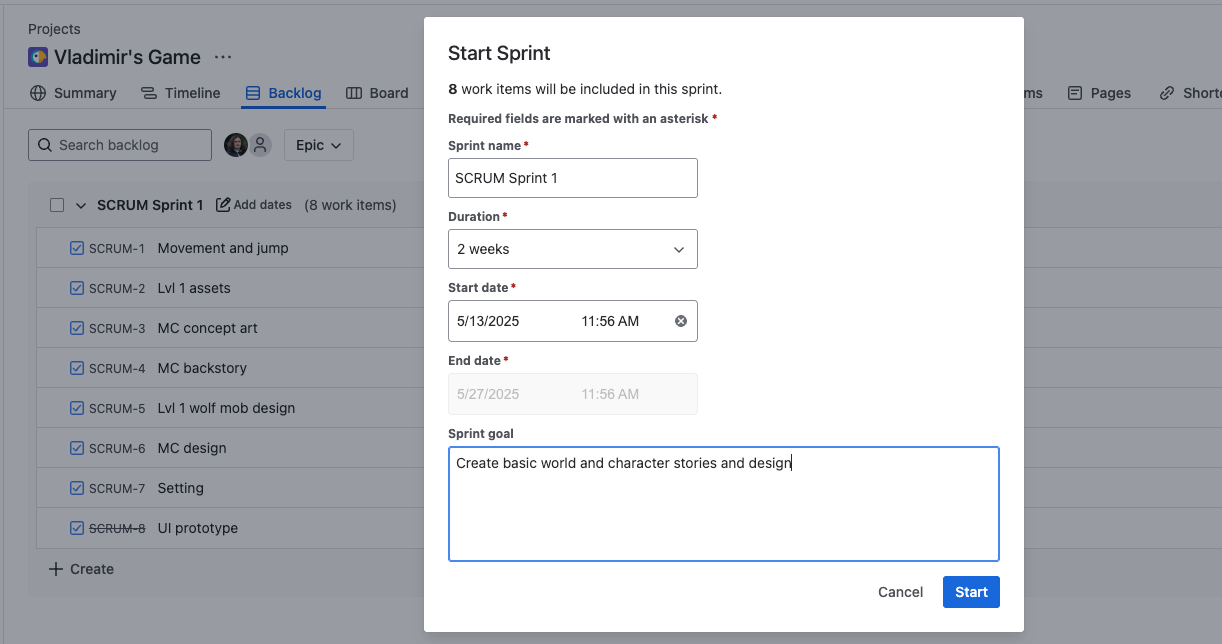
| Jira’s pros | Jira’s cons |
|---|---|
| – Supports both Kanban and Scrum workflows – Task dependencies – Fully customizable with 3,000+ integrations | – Unintuitive – Steep learning curve — not fit for company-wide adoption |
When creating a task in Jira — in addition to adding features like task dependencies and milestones (called Epic Links) — Jira allows you to immediately make the task a part of a Sprint.
While this feature may be simple, it could be critical for game development teams that use Scrum. Plus, there are even Sprint reports.
But the fact that Jira is a project management tool made by developers, for developers, is a double-edged sword.
If you’re part of a big company and want to implement a project management solution for everyone across all departments — then Jira shouldn’t be your top pick.
Why? Well, since it’s so powerful, Jira is also rather easy to break if you don’t know what you’re doing. And it’s not easy to pick up.
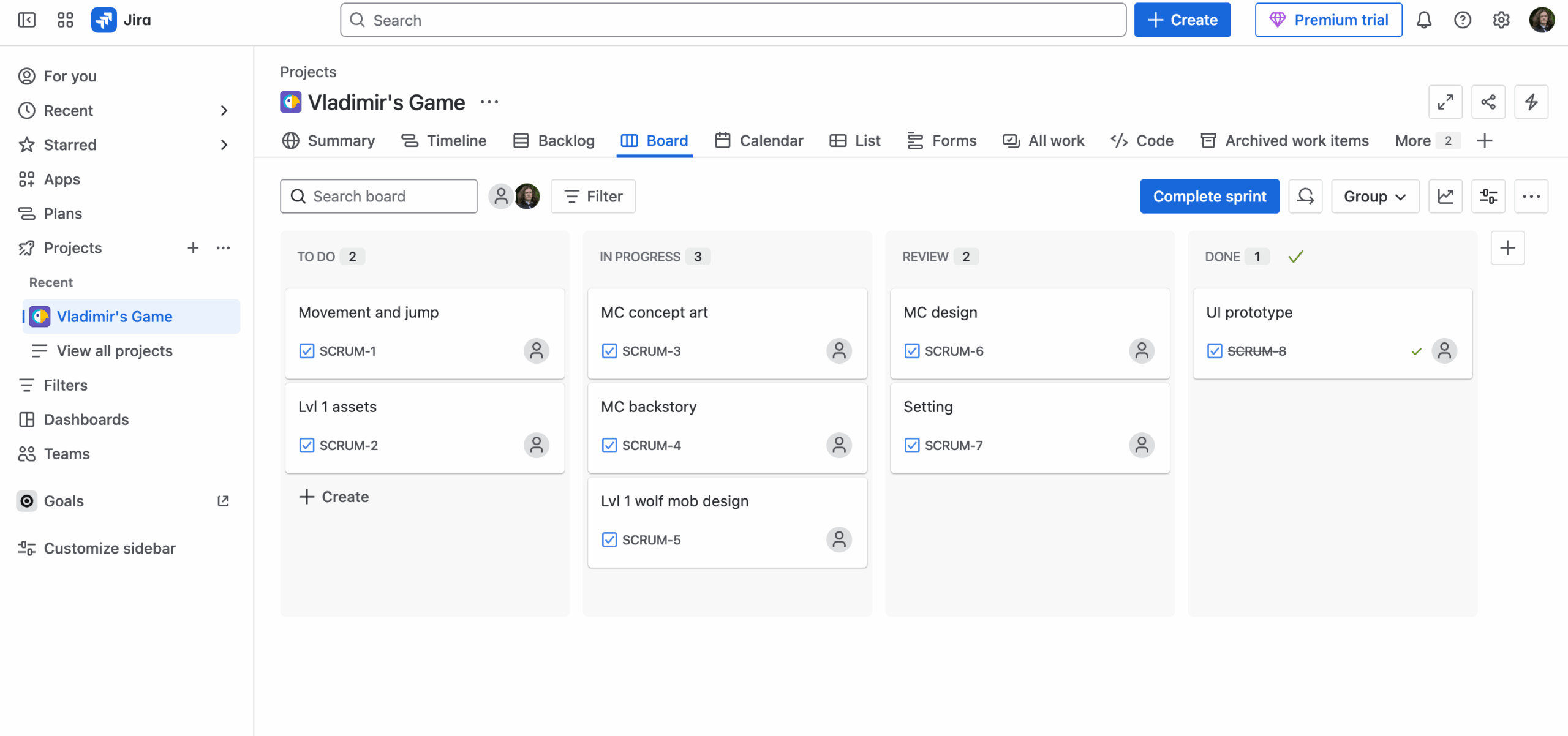
In short, Jira’s developer-first philosophy leaves a lot to be desired for other teams. And, the company that made Jira — Atlassian — knows this, or they wouldn’t have acquired Trello in 2017 and continued support to cater to non-developers.
On the upside, most games are made by smaller teams that may only consist of developers. In this case, Jira might be an appealing choice.
What’s new in Jira?
At the time of writing this review, Jira was in the process of (slowly) rolling out new navigation. Hopefully, this will mitigate Jira’s biggest con — the fact that it’s not user-friendly at all. But this is still in the realm of speculation.
Available platforms: web, Windows, macOS, Linux, Amazon Web Services, Microsoft Azure, Android, iOS
| Jira’s plans | Jira’s pricing |
|---|---|
| Free | $0 (up to 10 users) |
| Standard | $8.60/user/month* (up to 100 users) |
| Premium | $17/user/month* (up to 100 users) |
| Enterprise | POA |
*billed monthly
#5 Trello — best for a transparent game development process
Trello is one of the most popular and well-established Kanban board-oriented PM tools out there.
To put things in perspective, both HacknPlan and Codecks market themselves as Trello for game developers.
Why choose Trello?
While Trello’s Kanban boards are great, other tools don’t lag too far behind in this regard. Instead, I would argue that Trello’s most unique feature for game development is the ability to make certain boards publicly available for viewing.
You’ll often see certain Kickstarter or Patreon-backed games do this to show the state and progress of game development to the project backers.
If you’re considering this type of funding for your project, and you don’t have a lot of people working on it, you can use Trello to show your fans and backers how the game is coming along.
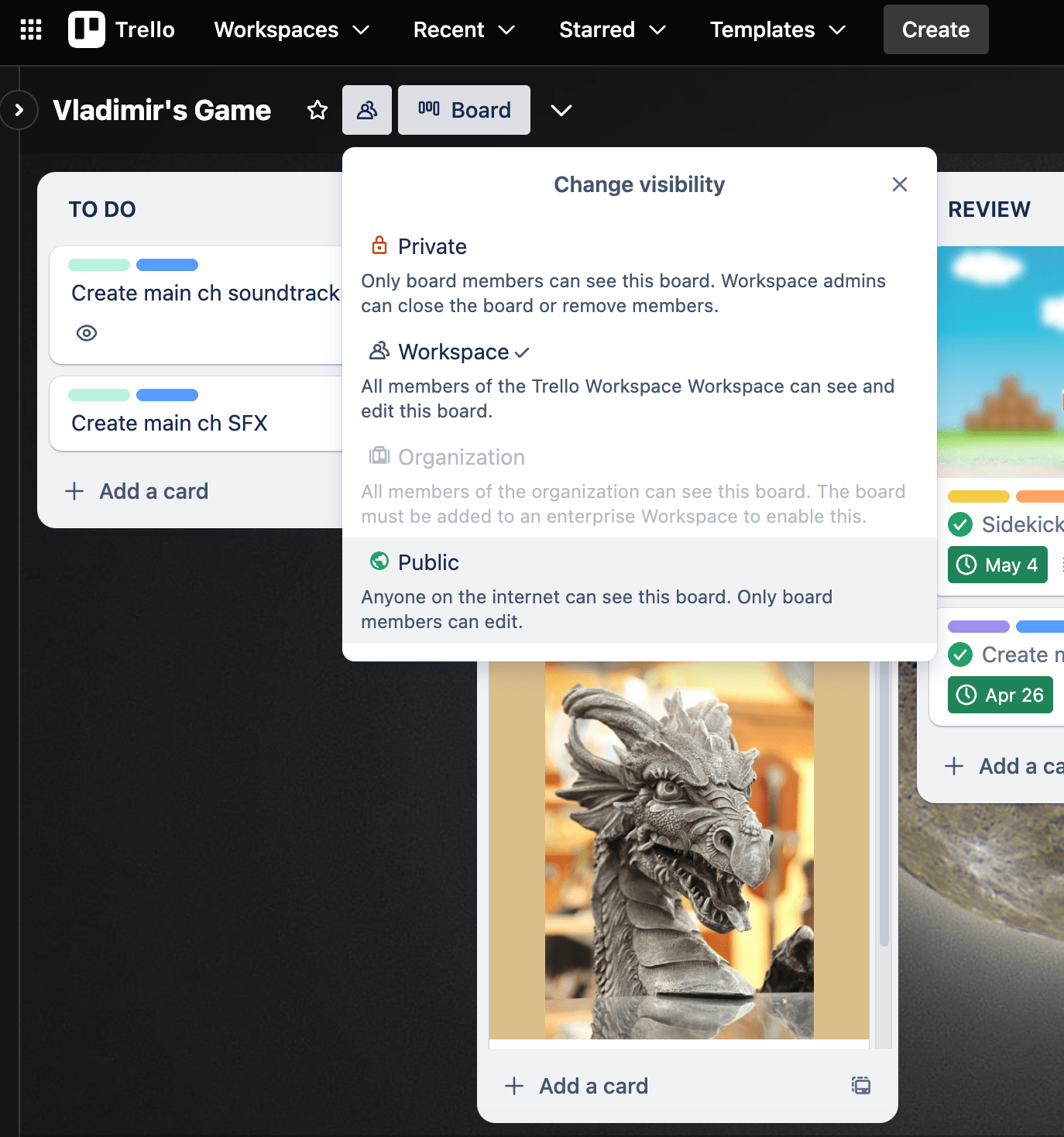
| Trello’s pros | Trello’s cons |
|---|---|
| – Unmatched Kanban workflow – Easy to use- 200+ integrations to choose from – Card Mirroring improves cross-team collaboration | – Offers very little beyond its Kanban workflow without (costly) integrations |
As a Kanban board, Trello is amazingly polished. However, aside from this basic functionality of dragging and dropping task cards from one column into the next, Trello doesn’t offer anything out of the ordinary.
Users can customize their Kanban boards to support a wide range of different development pipelines with Power-Ups — additional functionalities that include different views, integrations, and features. But, searching for relevant features in a list of 200+ Power-Ups, installing them, and then testing them out can be bothersome.
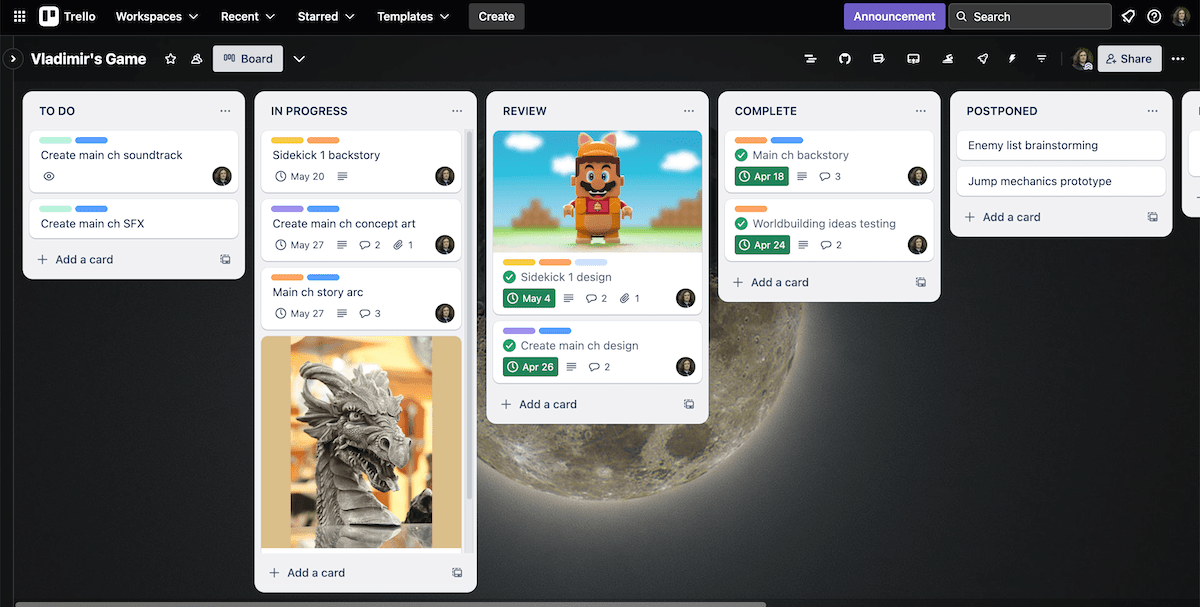
Still, if all you need is a Kanban board, then Trello has got you covered. It could be a good pick for solo projects or small development teams.
What’s new in Trello?
The Card Mirroring lets you synchronize a single card across multiple boards, letting you keep track of relevant tasks from multiple boards in one place.
Available platforms: web, Windows, macOS, Android, iOS
| Trello’s plans | Trello’s pricing |
|---|---|
| Free | $0 |
| Standard | $5/user/month* |
| Premium | $10/user/month* |
| Enterprise | $17.50/user/month (minimum 50 users)* |
*billed annually

#6 ClickUp — best for integrations with other apps
Like most entries on this list, ClickUp is a generalist project management tool.
While it doesn’t cater specifically to game development, ClickUp can support a wide variety of teams and workflows in the creative project management field — game development included.
Why choose ClickUp?
One of ClickUp’s most unique features is its connected search feature, which lets you connect ClickUp with other apps you’re using and use the search bar to pull up tasks from those apps — without leaving ClickUp. For game dev teams whose jobs require them to juggle development, design, marketing, etc., this feature can be rather helpful.
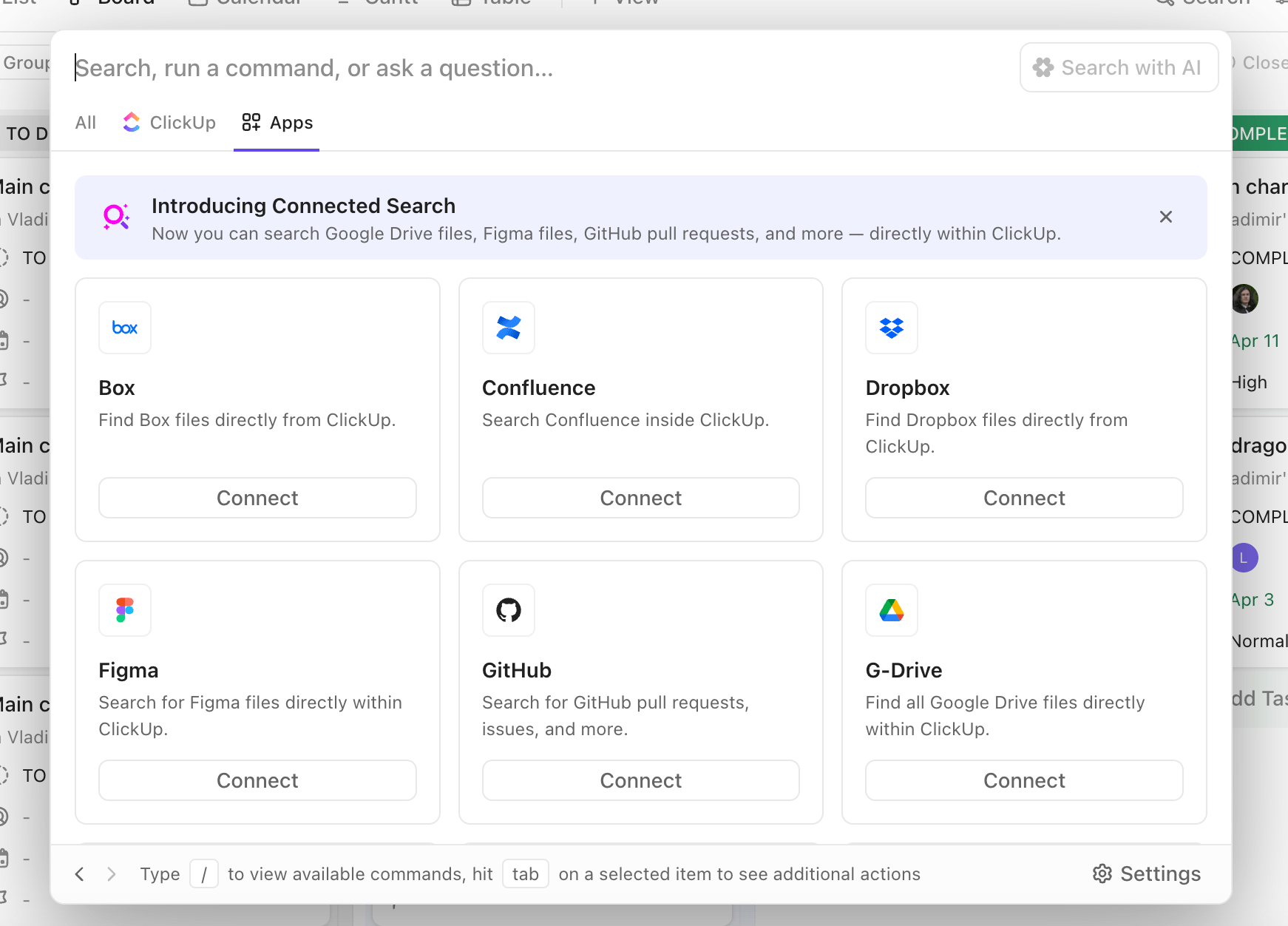
| ClickUp’s pros | ClickUp’s cons |
|---|---|
| – Versatile and customizable – Connected search feature lets you search tasks in other apps without leaving ClickUp – Free plan supports unlimited users | – Feature bloat, which results in unequal polish across different features |
In ClickUp, you can easily search for a GitHub task, a Google Drive file, or a Google Calendar event, all in the same place. Essentially, you don’t have to log into each of those apps separately, which should help minimize distractions and maximize productivity. Recently, they even included Microsoft Teams in the list of supported tools for this feature.
Similar to tools like Plaky, you can view your tasks in ClickUp in either a Kanban board view or a task list view. For every task, you can also add assignees, due dates, priorities, and other similar data.
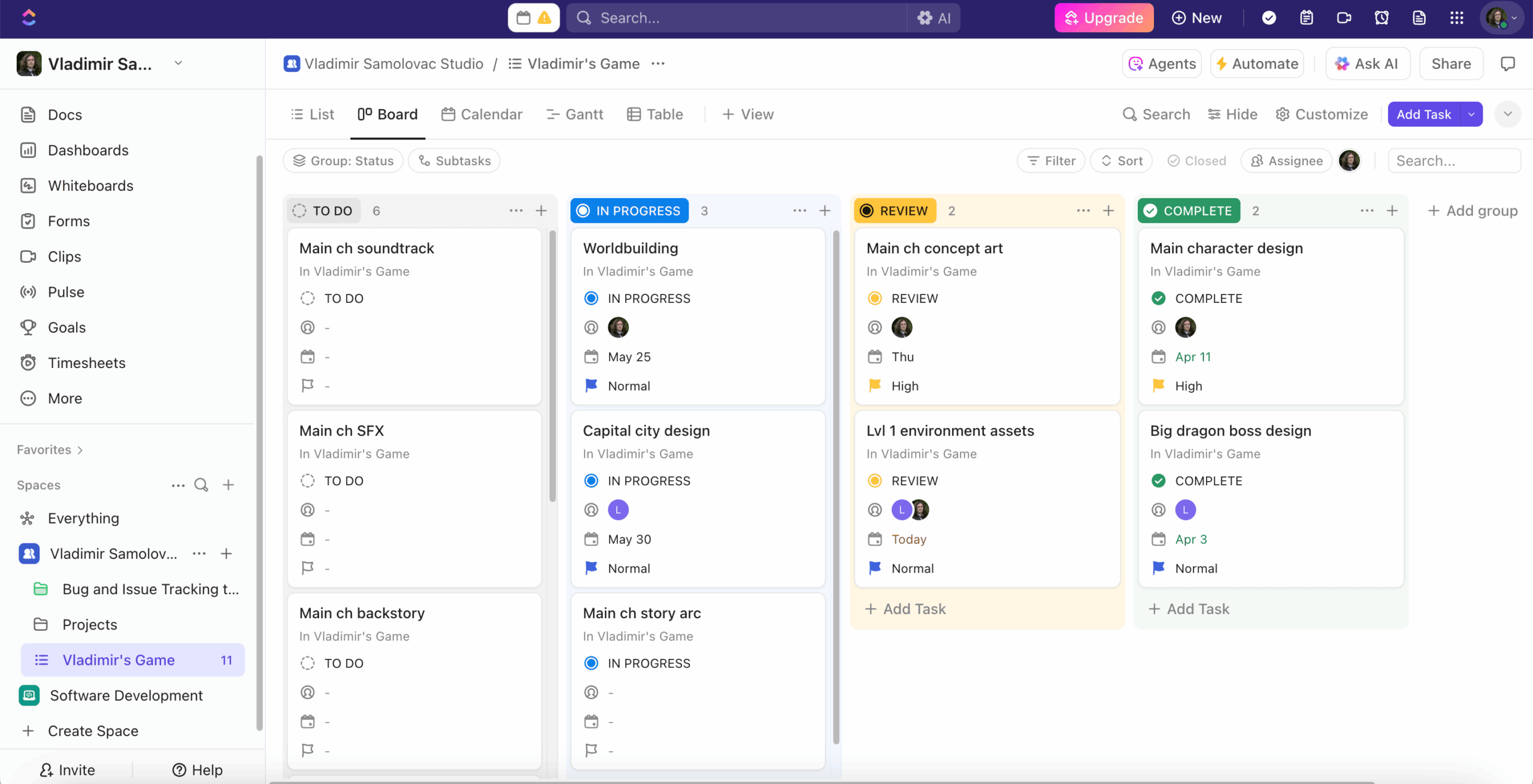
However, the thing that holds ClickUp back is that it’s got too many features to wrap your head around. This makes it harder to pick up, as it takes a while to navigate your way around the feature bloat and understand what’s useful and what you should learn to ignore.
To make matters worse, the features don’t all have the same polish, giving off the vibe of quantity over quality.
What’s new in ClickUp?
Rich link previews let you minimize distractions by showing you the context of links without having to click on them.
Available platforms: web, Windows, macOS, Linux, Android, iOS
| ClickUp’s plans | ClickUp’s pricing |
|---|---|
| Free | $0 |
| Unlimited | $7/user/month* |
| Business | $12/user/month* |
| Enterprise | POA |
*billed annually
#7 Asana — best for workload management
Lastly, there’s Asana, another generalist project management tool with multiple views, granular task management, and in-task communication.
What sets it apart is that, like Jira, Asana is another tool for Agile project management that features automated Sprints for Scrum teams.
Why choose Asana?
In my opinion, the thing that makes Asana stand out is its workload feature, which helps your team members avoid burnout and spread work evenly.
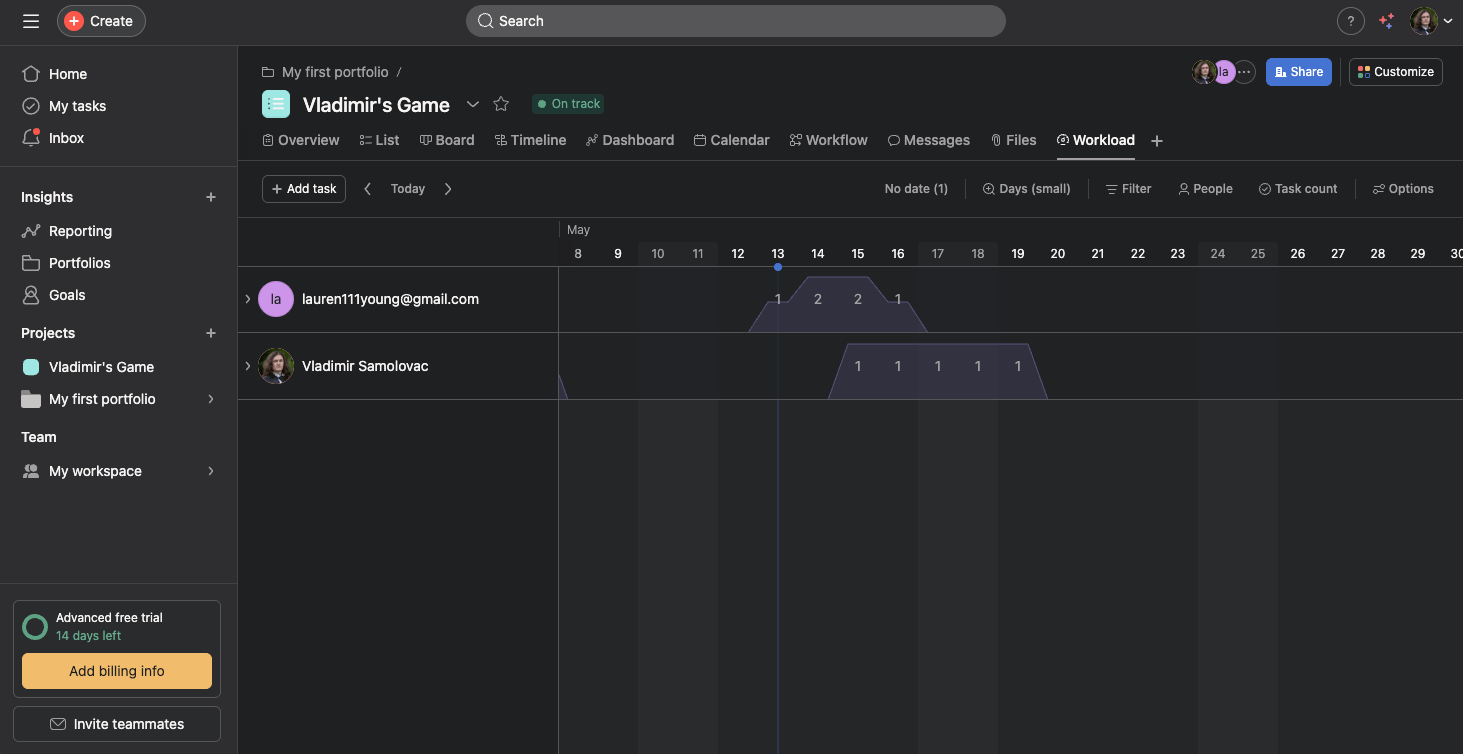
| Asana’s pros | Asana’s cons |
|---|---|
| – Supports Sprints – The workload feature helps keep workloads even among team members – Strategy maps help keep development on track | – Expensive – The free plan is limited to 10 people |
With Asana’s workload feature, you can keep track of resource loading per member and use simple color-coding to signal how crammed someone’s schedule is. That way, Asana helps your team stay Lean by avoiding mura — waste caused by uneven workload.
In addition to all the standard project management features, Asana also recently added the strategy map feature. This helps you visualize how project goals connect to tasks, which, in turn, helps keep your day-to-day game development efforts in line with the project vision.
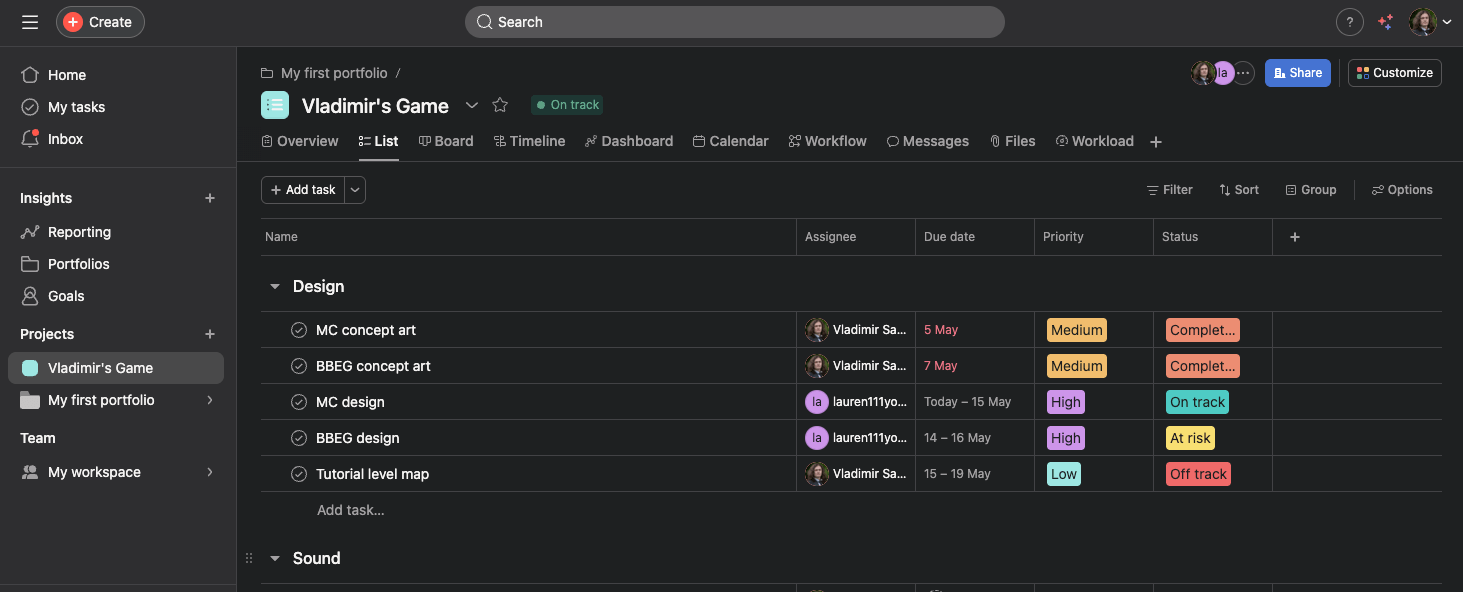
However, while Asana does technically have a free plan, it’s incredibly restrictive, with a user cap of 10. Couple this with its very steep price for the lowest-tier paid plan, and you’ve got a tool that actively discourages team expansion.
To put things in perspective with actual numbers, while a 10-person team can use Asana for free without issues, hiring the 11th team member will immediately propel the annual cost of using it from $0 to $1,400.
What’s new in Asana?
Apart from strategy maps, Asana recently added custom task types and statuses, as well as automated status updates, both of which could help game dev teams optimize their workflows.
Available platforms: web, Windows, macOS, Android, iOS
| Asana’s plans | Asana’s pricing |
|---|---|
| Personal | $0 (up to 10 users) |
| Starter | $10.99/user/month* |
| Advanced | $24.99/user/month* |
| Enterprise | POA |
| Enterprise+ | POA |
*billed annually
What is game development project management software?
Truth be told, project management software for game development usually has the same core functionalities as a regular PM tool, which is why a lot of the tools featured in this guide work just as well in other industries. In general, its purpose is to give you insight into:
- Task management and priority,
- Project planning and scheduling,
- Communication,
- Time management,
- Documentation,
- Reporting, and
- Project deliverable progress.

How to choose the right PM tool for your game development project
All the creative project management tools featured in this guide share the same basic features you need to manage game development projects. They can all get the job done.
So, when choosing the best one for you, you should focus on:
- The price — In addition to staying within budget, it’s best to pick a tool that doesn’t stifle growth by arbitrarily limiting access to features behind paywalls.
- The visual orientation — Make sure that the tool supports the kind of task management layouts that you’ll actually use (table, Kanban, Gantt, etc.). Even better if they’re customizable.
- Unique features — While most of these tools share a basic feature set, they all have some unique features that may be irreplaceable for your game development process. Don’t be blinded by bells and whistles you’ll never use, but also don’t undervalue functionalities that you’d actually use.
Level up your game development with Plaky
Without project management tools, game development is left without an organizational foothold. The more people are involved in a project, the more difficult it is to manage without a centralized platform that maintains its vision and streamlines production pipelines.
However, choosing a PM tool at random can incur more costs than benefits — both monetary and otherwise.
All the tools featured in this guide are excellent in their own ways. But, deciding what the best project management software for game development is is contextually dependent.
To find the right software for your team, you should always ask yourself:
- What features your team needs,
- Which layout works best for them, and
- What your budget is.
A Venn diagram of these 3 aspects will reveal the perfect tool for you in the middle. And if you look closely — Plaky will stand out as the top choice because:
- It has all the features you’ll realistically need even in its free plan,
- It allows you to switch between several views and fully customize your task management, and
- It supports unlimited users on all plans, so it won’t ever hold your projects hostage by forcing you to upgrade to a higher plan should you wish to expand your team.
Bring your games to life with Plaky. Sign up for a free account now!

